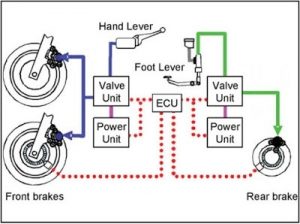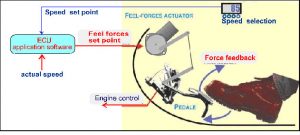The more Teslas in circulation – a function of more of them being mandated via “zero emissions” (which they aren’t) production quotas, which only electric cars qualify for – the more they keep running into things.
A video has emerged from China, where Teslas are mandated in even greater numbers – that shows one running amok, at Ludicrous Speed.
Without Ludicrous Braking.
The car reportedly blew through a gate at a more than 50 MPH and somersaulted to the top of the heap of parked cars it crashed into. The driver, who apparently survived, claims the car accelerated on its own and refused to brake – either on its own or with him applying the brakes, which he says he was.
“Autopilot was not turned on and the brakes were stepped on,” a translated version of the text accompanying the video says.
This actually unintended acceleration – as contrasted with the acceleration caused by the actual flooring of the accelerator pedal, unintentionally – as a few addled Audi drivers did back in the ‘80s – is a function of something ‘80s-era Audis didn’t have.
Drive-by-wire-accelerator pedals.
Almost all new cars have them.
It is a system in which the pedal you step on isn’t physically connected to the engine’s throttle – whether mechanical or electric. It is merely a sensory input device that “reads” the degree of arc the pedal travels as you depress it and then relays this information to a computer, which translates that – hopefully – into the corollary degree of engine output and, thereby, acceleration.
If it is not out of its senses.
If it correctly interprets the degree of arc you’ve depressed the pedal. If it does not sense you’ve floored it when you haven’t touched it.
If it does, the engine will rev – or the motor spin – and the car will accelerate.
What happens next depends on what else is controlled by the computer. In many cars, the transmission is, too. When you move the selector from Park to Drive, you are merely sending a signal to the computer to disengage Park and put the transmission into Drive. Your hand – via the lever or the button or whatever the input is – doesn’t physically connect to anything.
If the computer doesn’t want the transmission to disengage Drive, all your tapping and swiping and tugging won’t change its mind.
Which leaves the brakes.
Which are also increasingly under the control of the computer.
Computer control is the key element of what is styled “Automatic Emergency Brake Assist” or something similar. It applies the brakes when it thinks there’s a reason to. Which implies it could decide not to.
Or just forget.
In most cars, the brakes are still mechanical – or rather, hydraulic – and controlled mechanically. But this doesn’t preclude the elimination of direct driver control of them anymore than it precluded physical control over the throttle or the gear selector and the same rationales will likely be asserted to put the brakes under the total control of the computer, too.
Using drive-by-wire and sensors in lieu of physical cables and pedals makes assembly and manufacturing simpler and easier and more consistent. Plug-and-play. The coding homogenizes feel. The same basic idea that makes a Big Mac the same in San Francisco as in New York, but applied to something that can move very fast – with you in it.
It is harder to set something like throttle cable tension (and throttle response) exactly the same in every one of tens of thousands of cars that come down an assembly line. The same for adjusting how a gear selector selects gears.
And probably soon, how a car brakes.
They already brake without emergencies. Random sudden stopping.
This is a known issue – though not much is being done about it. The reason for that bringing us to the reason for all of it, which is to transform cars into Universal Modules that are controlled by us as little as possible.
This includes control in emergencies – as when the “advanced safety systems” go Azlheimerian. You lose control of acceleration – and you can’t brake.
It makes for one Hell of a ride.
And you don’t have to buy an electric ticket to take one, either.
. . .
Got a question about cars, Libertarian politics – or anything else? Click on the “ask Eric” link and send ’em in!
If you like what you’ve found here please consider supporting EPautos.
We depend on you to keep the wheels turning!
Our donate button is here.
If you prefer not to use PayPal, our mailing address is:
EPautos
721 Hummingbird Lane SE
Copper Hill, VA 24079
PS: Get an EPautos magnet or sticker or coaster in return for a $20 or more one-time donation or a $10 or more monthly recurring donation. (Please be sure to tell us you want a magnet or sticker or coaster – and also, provide an address, so we know where to mail the thing!)
If you’d like an ear tag – custom made! – just ask and it will be delivered.
My latest eBook is also available for your favorite price – free! Click here. If that fails, email me at EPeters952@yahoo.com and I will send you a copy directly!














This is a classic wrong pedal stomp. Driver idles up to gate (Tesla’s do idle don’t they?) thinking his foot is resting on brake. Gentle press causes unintended acceleration causes panic brake stomp causes 0 to 60 in 3.5 secs. No one EVER admits they stomped the gas. Always a mysterious mechanical issue that only crops up when parking or idling in traffic etc
PS this is why you NEVER take your right foot off accelerator except to hit brake. Resting it on the brake or in front of pedals is asking for this type of accident.
This makes absolutely no sense.
Computers never crash.
☮
If man made it, it’s going to break. How and when are the variables. In a more mechanical system, breakage can sometimes be predicted, and corrected before a catastrophic incident. It’s called maintenance. In a cyber controlled system, there is often no evidence at all that such breakage is eminent, until it fails, catastrophically. You can inspect a fan belt, brake pads, etc. You cannot inspect software. It either works, or it doesn’t, sometimes at the most inopportune moment. Computer control has abundant advantages, increasing fuel mileage for example, but in many cases provides no advantage other than creating a product that cost little and can be charged a high price for. Does drive by wire work? Of course it does, most of the time. Does it provide an actual improvement in performance and durability? Back in 2006 I was in the market for a new sports car. Of course I tested an MX5, and since the BMW dealership was in the same building, tested a Z4 as well. Both were in my price range. The Mazda had hydraulic steering, the BMW electric, which I didn’t know until later. After I had determined that the hydraulic in the Mazda was superior in feedback to the electric in the BMW.
Not sure I’d trust any story out of China about American products these days. Ever since we turned the HAARP weather control machine on them, the color revolution attempt in Hong Kong, and unleashing of the Wuhan Flu at that military competition, they’ve been plotting their retaliation!
That thing was doing more than 50, let me tell ya… LOL. I’ll bet that persons larynx is totaled with all the screaming.
Yep,,, everything today has to be electronic,,, just because. It’s the 21st century after all. Computers everywhere you don’t need them and of course computers never fail or make mistakes. Only humans do and AI aims to prevent that. Problem is it’s all Artificial and no Intelligence. Look at what programmed them.
A loose connection,,, a little water intrusion,,, high humidity,,, bad solder joint,,, a finicky power supply,,, lightening storm,,, too hot,,, too cold,,, etc. All to keep from running one small cable to a air intake butterfly,,, or one cable for emergency brake,,, or one lever to operate power brakes,,, or one lever to shift the tranny or a positive connection from steering wheel to hydraulic actuator.
A button is used to start the thing instead of a key taking us back 50 years. Instead of a knob we have to swipe and tap (and sometimes pound) to operate the A/C,,, radio and other conveniences.
Want to move over a little in the oncoming lane a little to not run over a cyclist, lights flash, horns blast, steering wheel shudders and attempts to hit the cyclist.
Push the Emergency brake button and you impress everyone doing your version of the old bootleggers turn.
Look at your side mirror a second too long lights flash, horns sound and a voice tells you to look ahead. Next will be electric shock to “awaken” you.
Have an emergency,,, need to get your wife to a hospital Stat!,,, too bad you took that sip of NyQuil earlier,,, no start as the computer will sense alcohol.
Everything is so much better today!
While I can see the “assists” being an issue, I can’t see how the drive by wire tech would pose a problem. After all, it’s a mature technology, having been used in aircraft for decades. The F-16 fighter, which entered service in 1978, pioneered it in military aircraft; the Airbus A-320, which entered service in 1988, was the first civilian aircraft with fly by wire. The technology is over 40 years old, Folks! Drive by wire is the same tech adapted for cars. Ergo, I can’t see WHY it would be a problem in cars…
Hi Mark,
Aviation . . . apples and oranges. Think of the maintenance/service protocols a military jet (or a civilian aircraft) is subject to. Now think about how cars are maintained. Imagine an F18 that was just … flown for 18 years… without major checkouts after practically every flight.
Eric, that’s a good point about the maintenance protocols both military and civilian aircraft are subject to. That said, the Tesla was new, so maintenance shouldn’t have been an issue-at least not yet.
Hi Mark,
Tesla has had major issues with quality control – which of course have not been generally covered, for all the usual reasons. The bottom line – for me – is that physical controls are inherently safer, in general automotive systems, at least. You can pull on a stuck cable; you can put a running-amok engine into neutral. You have no physical control over drive-by-wire. If it goes haywire, you go along for the ride.
You’re right about Tesla’s QC issues. I too prefer PHYSICAL controls…
More importantly, there are backups and backups, checklists for dealing with failures, and in many cases there’s still manual overrides available.
Training goes a long way, as does certain death (vs inconvenience) when the vehicle fails.
We know this is coming across the board. Doubt there’s much we mere mortals can do anything about it, except use/buy our preference as long as we can.
It reminds me of the old University vs Fraternity tricks. They tried changing big things, got big pushback, then moved to changing a little at a time, so the incoming Freshmen knew no different than the older Seniors. In 4+ years the Univ. got what they wanted all along.
I will add some pertinent experience Re-E-crap: I needed a farm tractor. Settled on J-D for their overall superior package in the category I needed (35HP mid size). When I went to buy, in 2002 mind you, it was the first year with their new e-control for their e-hydro drive system. And it was ALL e-control from the forward and reverse pedals being on servos, to drive-the-pile load sensors, etc…. I was like ohhh oooo. It does have a manually actuated brake system though that never gets used because the e-hydro does the braking 99% of the time.
But I had little choice, cause NO one was giving up their non-E-control tractors at the time, scared like me over this stuff. 18 years later, nothing has failed, except a simple relay. Nothing………… and I beat the crap out of it doing things it was not designed for. Call me surprised. I do keep it inside though, which I’m sure helps a ton. Now if it breaks now, I’m sure I’m screwed, but it owes me nothing to date. Granted an old non-e-crap tractor can probably go a lifetime, but those days are well behind us unfortunately.
“It makes for one Hell of a ride.” — EP
All your brake are belong to us!
Every new vehicle turned into a crash-by-wire 737 MAX (now restyled as the “737-8”).
We’re on the Highway to Hell, comrades.
Ride it over the cliff … or take a risky jump out the window into the woods?
LOL Today’s vehicles are death mobiles lol. I like my cable throttle, unfortunately I have ABS (anti-brake system) but it’s okay I removed the fuse. The insurance company should give me a discount since I have safer brakes & can stop shorter than all other vehicles on the road.
I’d actually be okay with electronic throttle, if there were a REASON for it LOL, all it does is take a perfect thing (the cable throttle) and make it complicated & unreliable. But I think it COULD be safe — it has dual sensors, the software/firmware self-diagnoses itself (it checks for all possible error conditions right before sending a command to the throttle servo motor), and there’s brake override, but the problem is some manufacturers don’t design & build them CORRECTLY [toy, ford, s.korea stuff, idk maybe others], that’s why there was all the death throttle crashes, also some of the throttle position sensors are junky/cheap although I don’t think that’s what actually caused any of the death throttle problems — I think it was software or computer-board-parts related. But big problems never happened to Nissan, European car co’s, Honda I think but not sure, etc. because they did things right LOL.
Hi Harry,
That’s just it – why fix what isn’t broken? A throttle cable is a simple control that’s inherently more long-term reliable and much easier/cheaper to repair.
The main reason, of course, is to decrease the driver’s control over how the engine/vehicle function. It all trends in that direction – with the end goal being a car over which the driver has no control.